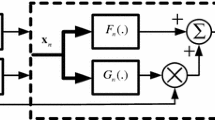Abstract
The lack of sensors for some relevant state variables in fermentation processes can be coped by developing appropriate software sensors. In this work, NARX-ANN, NARMAX-ANN, NARX-SVM and NARMAX-SVM models are compared when acting as software sensors of biomass concentration for a solid substrate cultivation (SSC) process. Results show that NARMAX-SVM outperforms the other models with an SMAPE index under 9 for a 20 % amplitude noise. In addition, NARMAX models perform better than NARX models under the same noise conditions because of their better predictive capabilities as they include prediction errors as inputs. In the case of perturbation of initial conditions of the autoregressive variable, NARX models exhibited better convergence capabilities. This work also confirms that a difficult to measure variable, like biomass concentration, can be estimated on-line from easy to measure variables like CO2 and O2 using an adequate software sensor based on computational intelligence techniques.








Similar content being viewed by others
References
Shukla R, Chand S, Sristava AK (2005) Improvement of gibberellic acid production using a model based fed-batch cultivation of Gibberella fujikuroi. Process Biochem 40(6):2045–2050
Box G, Jenkins G (1970) Time series analysis: forecasting and control. Holden-Day, San Francisco
Chai M-I, S, Song S, Li N-N (2005) A review of some main improved models for neural network forecasting in time series. In: Zeng D (ed) Proceedings of the IEEE intelligent vehicles symposium. (Issue 6–8), pp 866–868
Woolley J, Agarwal P, Baker J (2010) Modeling and prediction of chaotic systems with artificial neural networks. Int J Numer Methods Fluids 63(8):989–1004
Schölkopf B, Smola A, Williamson RC, Bartlett PL (2000) New support vector algorithms. Neural Comput 12(5):1207–1245
Sapankevych N, Sankar R (2009) Time series prediction using support vector machines: a survey. IEEE Comput Intell Mag 4(2):24–38
Jayawardena AW, Fernando DAK, Zhou MC (1997) Comparison of multilayer perceptron and radial basis function networks as tools for flood forecasting. Proceedings of the destructive water: water-caused natural Disasters, their abatement and control, Anaheim, California, p 173–181
Padmavathi J (2011) A comparative study on breast cancer prediction using RBF and MLP. Int J Sci Eng Res 2(1): 99, 1–5
Park J-W, Venayagamoorthy GK, Harley RG (2005) MLP/RBF neural-networks-Based online global model identification of synchronous generator. IEEE Trans Industr Electron 52(6):1685–1695
Haykin S (2009) Neural networks and learning machines, 3rd edn. Pearson Prentice Hall, USA
Hornik K (1991) Approximation capabilities of multilayer feed forward networks. Neural Netw 4(2):251–257
Vapnik V (1995) The nature of statistical learning theory. Springer Verlag, New York
Drucker H, Burges CJC, Kaufman L, Smola A, Vapnik V (1997) Support vector regression machines. In: Mozer M, Jordan M, Petsche T (eds) Advances in neural information processing systems 9. MIT Press, Cambridge, pp 155–161
Hamel L (2009) Knowledge discovery with support vector machines. John Wiley & Sons, New Jersey
Ljung L (1987) System identification: theory for the user. Prentice-Hall, Englewood Cliffs
Werbos PJ (1990) Backpropagation through time: what it does and how to do it. Proc IEEE 78(10):1550–1560
Suykens JAK, Van Gestel T, Brabanter De, De Moor B, Vandewalle J (2002) Least square support vector machines. World Scientific, Singapore
Acuña G, Ramirez C Curilem M (2012) Comparing NARX and NARMAX models using ANN and SVM for cash demand forecasting for ATM. In: Proceedings of the IEEE International Joint Conference on Neural Networks, IJCNN, p 1–6
Gelmi C, Perez-Correa R, Agosin E (2002) Modelling Gibberella fujikuroi growth and GA3 production on solid-state fermentation. Process Biochem 37(9):1033–1040
Garcia-Pedrero A, Gomez-Gil P (2010) Time series forecasting using recurrent neural networks and wavelet reconstructed signals. In: Proceedings of the 20th international conference on electronics, communications and computer, CONIELECOMP 2010, p 169
Norgaard M (2003) The NNSYSID toolbox, for use with Matlab. http://www.iau.dtu.dk/research/control/nnsysid.html
Canu S, Grandvalet Y, Guigue V, Rakotomamonjy A (2005) SVM and Kernel Methods Matlab toolbox. Perception Systèmes et Information, INSA de Rouen
Frohlich H, Zell A (2005) Efficient parameter selection for support vector machines in classification and regression via model-based global optimization. In: proceedings of the IEEE international joint conference on neural networks. IJCNN 2005:1431–1436
Chen Ping-Hei, Lee Ya-Wei, Chang Tien-Li (2009) Predicting thermal instability in a closed loop pulsating heat pipe system. Appl Therm Eng 29(8–9):1566–1576
Acknowledgments
This work was supported in part by the Chilean Government under Fondecyt Grant 1090316, the DICYT-USACH Grant 061219AL and the Dirección de Investigación, Universidad de La Frontera.
Author information
Authors and Affiliations
Corresponding author
Rights and permissions
About this article
Cite this article
Acuña, G., Ramirez, C. & Curilem, M. Software sensors for biomass concentration in a SSC process using artificial neural networks and support vector machine. Bioprocess Biosyst Eng 37, 27–36 (2014). https://doi.org/10.1007/s00449-013-0925-3
Received:
Accepted:
Published:
Issue Date:
DOI: https://doi.org/10.1007/s00449-013-0925-3




